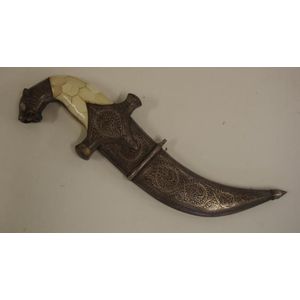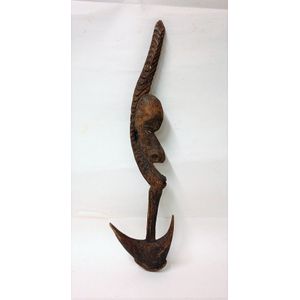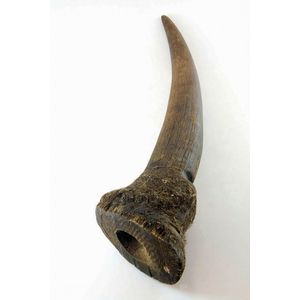Abelam Ancestor with Hornbill Finial
You must be a subscriber, and be logged in to view price and dealer details.
Subscribe Now to view actual auction price for this item
When you subscribe, you have the option of setting the currency in which to display prices to $Au, $US, $NZ or Stg.
- Hornbill - Oriental antique descriptions occasionally refer to "hornbill" or "hornbill ivory" as the material from which the object is made. In fact the hornbill is a large bird, the helmeted hornbill, found in a few South-East Asian countries, and the name is also applied to the material obtained from a growth on the upper section of the beak of the bird, known as a casque.
In its natural form it is a yellow colour, but when the hornbill rubs its beak while preening its feathers, the growth turns a red colour.
As well as being used as a carving material in areas where the bird is found, hornbill became popular as a carving medium with the Chinese in the 19th century, and it was prized (and priced) ahead of ivory and jade.
The helmeted hornbill is listed in Appendix 1 of CITES, (Convention on International Trade in Endangered Species) meaning that trade in hornbill objects requires import and export permits.
the s natural ivory from the bird, native to Indonesia. The hornbill is now an endangered species, but due to the apparent age of the jewelry, this item would be legal for trade. Hornbill ivory is not a true ivory as it is not a dentine material, but rather a keratin. Hornbill ivory of this nature was often carved from the lower layer of the hornbill casque for the western market. The upper area, with a strong red coloration, was traded to the Eastern market. The upper areas of these pieces yet show some of the red coloring. The rest is in the strong yellowish color of natural hornbill. - Finial - An architectural decoration, found on the upper parts of of an object. On furniture they are usually found on pediments, canopies and shelf supports. On smaller ceramic or silver items, such as spoons, they may decorate the top of the item itself, or the lid or cover where they provide a useful handle for removal.
Finials have a variety of shapes and forms. They may be urn-shaped, baluster shaped round or spiral, but usually taper into an upper point. Many real life shapes may also be used as finials, such as pineapples, berries, pinecones, buds, lotus and acorns. Sometimes animals such as a lion are depicted, or fish and dolphins.
This item has been included into following indexes:
Visually similar items

Damascus steel khanjar dagger with sheath, 30 cm wide

A finely incised and rare club, Wide Bay-Burnett Region, Queensland (nineteenth century), carved hardwood, 66.7 cm high. Provenance: Private Collection, Queensland

A PNG carved wooden food hook, the stylised mask with inset shell eyes, double pronged hook to the base. Old patination to the lightweight wood carving. Height 71.5 cm

Old mature bull, wide lipped rhino horn, 61 cm length
